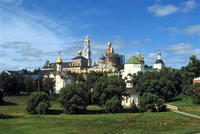You are in: Europe -> Russia -> Architectural Ensemb... , and traditional search or Image Gallery will yield results of this site only
Architectural Ensemble of the Trinity Sergius Lavra in Sergiev Posad
| Site number: | 657 |
|
| Type of site: | Cultural | |
| Date: | 15-18th century | |
| Date of Inscription: | 1993 | |
| Location: | Eurasia, Russian Federation, Moscow region, town Sergiev-Posad (ex Zagorsk) | |
Up to 75 images are shown here. Click on each for more details or on Image Gallery for more images.
| Description: | The still functioning Orthodox monastery incorporates military features typical of the 15th to the 18th century, the period of its construction. The tomb of Boris Godunov lies within the main church of the Lavra, the Cathedral of the Assumption (reiterating the Kremlin Cathedral of the same name). In the midst of the Lavra treasures is Andrei Rublev’s famous icon, The Trinity. --WHMNet paraphrase from the description at WHC Site, where additional information is available. | |
| The Trinity Lavra of St. Sergius (Russian: Тро́ице-Се́ргиева Ла́вра) is the most important Russian monastery and the spiritual centre of the Russian Orthodox Church. The monastery is situated in the town of Sergiyev Posad, about 90 km to the north-east from Moscow by the road leading to Yaroslavl. The monastery was founded in 1345 by one of the most venerated Russian saints, Sergius of Radonezh, who built a wooden church in honour of the Holy Trinity at the Makovets Hill. Early development of the monastic community is well documented in contemporary lives of Sergius and his disciples. In 1355, Sergius introduced a charter which required the construction of auxiliary buildings, such as refectory, kitchen, and bakery. This charter was a model for Sergius' numerous followers who founded more than 400 cloisters all over Russia, including the celebrated Solovetsky, Kirilov, and Simonov monasteries. St. Sergius supported Dmitri Donskoi in his struggle against the Tatars and sent two of his monks, Peresvet and Oslyabya, to participate in the Battle of Kulikovo (1380). At the outbreak of the battle, Peresvet died in a single combat against a Tatar bogatyr. The monastery was devastated by fire, when a Tatar unit raided the area in 1408. It took 26 years to construct the six-pillared Assumption Cathedral, which was commissioned by Ivan the Terrible in 1559. The cathedral is much larger than its model and namesake in the Moscow Kremlin. The magnificent iconostasis of the 16th–18th centuries features Simon Ushakov's masterpiece, the icon of Last Supper. Interior walls were painted with violet and blue frescoes by a team of Yaroslavl masters in 1684. The vault contains burials of Boris Godunov, his family and several 20th-century patriarchs. As the monastery grew into one of the wealthiest landowners in Russia, the woods where it had stood were cut over and a village (or posad) sprang up near the monastery walls. It gradually developed into the modern town of Sergiyev Posad. The cloister itself was a notable centre of chronicle-writing and icon painting. Just opposite monastery walls St. Paraskeva's Convent was established, among whose buildings St. Paraskeva's Church (1547), Introduction Church (1547), and a 17th-century chapel over St. Paraskeva's well are still visible. In 1993, the Trinity Lavra was inscribed on the UN World Heritage List. --Wikipedia. Text is available under the Creative Commons Attribution-ShareAlike License. | ||
| Source: | http://whc.unesco.org/en/list/657 | |
| Reference: | 1. UNESCO World Heritage Center, Site Page. | |





